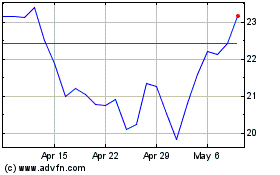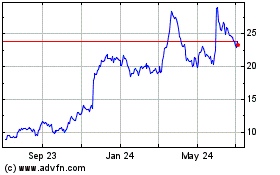By Suzanne Kapner
Leslie Wexner, the chief executive of L Brands Inc., saw the
changes that would roil today's apparel industry a decade ago.
In 2007, Mr. Wexner sold 75% of Limited Stores, once the
cornerstone of his empire, to the private-equity firm Sun Capital,
part of a broader move to focus on lingerie and personal-care
products through his Victoria's Secret and Bath & Body Works
brands.
Over the weekend, Limited Stores LLC said it would close all of
its 250 stores nationwide as it looks for a buyer for the
business.
Like Gap Inc., J. Crew Group Inc. and other apparel retailers,
the Limited has struggled to compete with fast-fashion and discount
sellers such as Zara and T.J. Maxx. In addition, declining foot
traffic at many shopping centers has hurt traditional mall stores
like the Limited.
It has the added burden of being saddled with debt. In a letter
to employees reviewed by The Wall Street Journal, Finance Chief
Larry Fultz said that due to a heavy debt load and tough retail
environment, the company has to be sold or it will close
altogether. In November, the Journal reported that the company
hired Guggenheim Partners to advise it on a possible sale.
"Private equity has been a curse on retail," said Howard
Davidowitz, the chairman of Davidowitz & Associates Inc., a
consulting and investment banking firm, explaining that retailers
lack the steady earnings stream to service the debt typically
associated with these deals.
A call to Sun Capital was referred to a representative for the
Limited, who declined to comment.
In 1963, Mr. Wexner opened the first Limited -- a nod to its
narrow focus on women's sportswear -- in Columbus, Ohio. He became
known for his sharp merchandising skills.
"When he believed in something, he bought it to the moon," Mr.
Davidowitz said. "When you went into the stores, they had it in
every color and the display was so dramatic."
Other innovations included stocking new merchandise every five
or six weeks rather than every four or five months, Mr. Davidowitz
said. And like the fast-fashion chains of today, Mr. Wexner tested
small batches of goods before introducing them chainwide.
Realizing early on the importance of sourcing, he bought Mast
Industries, an apparel importer that he later sold to
private-equity firm Sycamore Partners.
By 1995, Limited had grown to more than 700 stores, and Mr.
Wexner's company, then called Limited Brands Inc., largely
consisted of apparel chains, including Express, Abercrombie &
Fitch Co., Lerner New York, Lane Bryant, Henri Bendel and The
Limited Too.
Over the next decade, however, the CEO backed away from apparel,
selling or spinning off many of those chains and instead focused on
growing Victoria's Secret and Bath & Body Works. He changed
Limited Brands's name to L Brands in 2013.
"These changes are born of careful and I believe thoughtful
strategy shifts," Mr. Wexner said in 2007 when he announced the
sale of Express to Golden Gate Capital.
The Limited was already struggling before its sale to Sun
Capital. By February 2007, its store count had shrunk to 260, and
its sales had fallen to $493 million from $577 million three years
earlier.
Its parent didn't receive any cash proceeds from the sale, and
instead recorded a $72 million pretax loss. Sun Capital contributed
$50 million in equity and arranged a $75 million credit facility
for a 75% stake. It acquired the remaining 25% of the company in
2010.
"Limited failed to change their approach to a rapidly changing
consumer, " said Liz Dunn, CEO of consulting firm Talmage Advisors.
"Their stores were too big, their assortment wasn't that special,
and the brand became stale."
It is a predicament faced by myriad apparel sellers, including
American Apparel LLC, Aéropostale Inc., Pacific Sunwear of
California Inc. and Wet Seal Inc., which have each filed for
bankruptcy protection in recent years.
"The old playbook has stopped working," Ms. Dunn said. "It's
evolve, or die."
--Lillian Rizzo contributed to this article.
Write to Suzanne Kapner at Suzanne.Kapner@wsj.com
(END) Dow Jones Newswires
January 10, 2017 06:53 ET (11:53 GMT)
Copyright (c) 2017 Dow Jones & Company, Inc.
Gap (NYSE:GPS)
Historical Stock Chart
From Mar 2024 to Apr 2024

Gap (NYSE:GPS)
Historical Stock Chart
From Apr 2023 to Apr 2024
